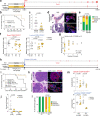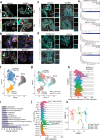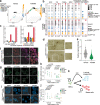Breast cancer prevention by short-term inhibition of TGFβ signaling
- PMID: 36476730
- PMCID: PMC9729304
- DOI: 10.1038/s41467-022-35043-5
Breast cancer prevention by short-term inhibition of TGFβ signaling
Abstract
Cancer prevention has a profound impact on cancer-associated mortality and morbidity. We previously identified TGFβ signaling as a candidate regulator of mammary epithelial cells associated with breast cancer risk. Here, we show that short-term TGFBR inhibitor (TGFBRi) treatment of peripubertal ACI inbred and Sprague Dawley outbred rats induces lasting changes and prevents estrogen- and carcinogen-induced mammary tumors, respectively. We identify TGFBRi-responsive cell populations by single cell RNA-sequencing, including a unique epithelial subpopulation designated secretory basal cells (SBCs) with progenitor features. We detect SBCs in normal human breast tissues and find them to be associated with breast cancer risk. Interactome analysis identifies SBCs as the most interactive cell population and the main source of insulin-IGF signaling. Accordingly, inhibition of TGFBR and IGF1R decrease proliferation of organoid cultures. Our results reveal a critical role for TGFβ in regulating mammary epithelial cells relevant to breast cancer and serve as a proof-of-principle cancer prevention strategy.
© 2022. The Author(s).
Conflict of interest statement
The authors declare competing financial interests: K.P. serves on the Scientific Advisory Board of Acrivon Therapeutics, Vividion Therapeutics, Novartis, and Scorpion Therapeutics, holds equity options in Scorpion Therapeutics, receives grant support from Novartis, is a consultant to Aria Pharmaceuticals, and in the past 12 months received an honorarium from Astra-Zeneca, Roche, and New Equilibrium Biosciences. F.M. is a cofounder of and has equity in Harbinger Health, has equity in Zephyr AI, and serves as a consultant for Harbinger Health, Zephyr AI, and Red Cell Partners. F.M. declares that none of these relationships are directly or indirectly related to the content of this manuscript. The remaining authors declare no competing interests.
Figures





References
-
- Day R, National Surgical Adjuvant B, Bowel Projet PS. Quality of life and tamoxifen in a breast cancer prevention trial: a summary of findings from the NSABP P-1 study. National Surgical Adjuvant Breast and Bowel Project. Ann. N. Y Acad. Sci. 2001;949:143–150. doi: 10.1111/j.1749-6632.2001.tb04012.x. - DOI - PubMed
Publication types
MeSH terms
Grants and funding
LinkOut - more resources
Full Text Sources
Medical
Molecular Biology Databases

